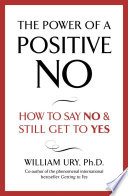

The book begins with a fundamental premise: saying 'no' is essential for maintaining personal integrity and prioritizing commitments. It emphasizes that a positive 'no' is not merely a refusal but a powerful assertion of one's values and priorities. When we say 'no,' we are not just rejecting requests; we are affirming our own goals and boundaries. This understanding helps individuals to realize that a 'no' can be a constructive response that paves the way for healthier relationships and clearer communication. By acknowledging the importance of saying 'no,' the reader can begin to appreciate how it serves as a protective mechanism against overcommitment and stress.
Continue readingThe book delves into the nuanced art of delivering a 'no' that is both respectful and firm. It suggests that the way a 'no' is communicated can significantly affect the outcome of the interaction. The author provides practical strategies for how to articulate a 'no' effectively, including using empathetic language, maintaining a calm demeanor, and offering alternatives when appropriate. This section is particularly useful for those who struggle with confrontation or fear of disappointing others, as it provides a framework for delivering difficult messages while preserving relationships.
Continue readingA significant theme in the book is the alignment of one's decisions with personal values and goals. The author encourages readers to reflect on their priorities and to use these as a guide when faced with requests or demands. By being clear about what matters most, individuals can make more informed decisions about when to say 'yes' and when to say 'no.' This alignment fosters a sense of authenticity and self-awareness, empowering readers to stand firm in their choices and to navigate challenges with confidence.
Continue readingEstablishing healthy boundaries is a crucial aspect of the book's message. The author explains that boundaries are not just limits imposed on others but are essential for self-care and personal well-being. By setting clear boundaries, individuals can protect their time, energy, and emotional health. The book provides insights into how to communicate these boundaries effectively, helping readers to understand that saying 'no' is often a necessary step in maintaining those boundaries and ensuring a balanced life.
Continue readingThe book also addresses the potential negative consequences of failing to say 'no.' It highlights how an inability to refuse requests can lead to burnout, resentment, and a loss of control over one's own life. By exploring real-life examples, the author illustrates the ripple effects of overcommitment, encouraging readers to recognize the importance of self-advocacy. This section serves as a wake-up call for those who may be stuck in a cycle of people-pleasing, prompting them to reassess their choices and prioritize their own needs.
Continue readingA key takeaway from the book is the development of confidence in decision-making. The author provides tools and exercises designed to help readers strengthen their ability to make choices that align with their values. This includes techniques for assessing requests, weighing pros and cons, and practicing assertiveness. By building this confidence, individuals can become more decisive and proactive in their lives, reducing anxiety and increasing satisfaction with their choices.
Continue readingFinally, the book emphasizes that a positive 'no' can lead to constructive outcomes. By framing refusals in a way that is respectful and considerate, individuals can maintain relationships and open the door for future collaboration. The author encourages readers to view 'no' as a starting point for negotiation rather than an endpoint. This perspective fosters a collaborative spirit and encourages creative problem-solving, ultimately leading to more positive interactions and outcomes.
Continue reading